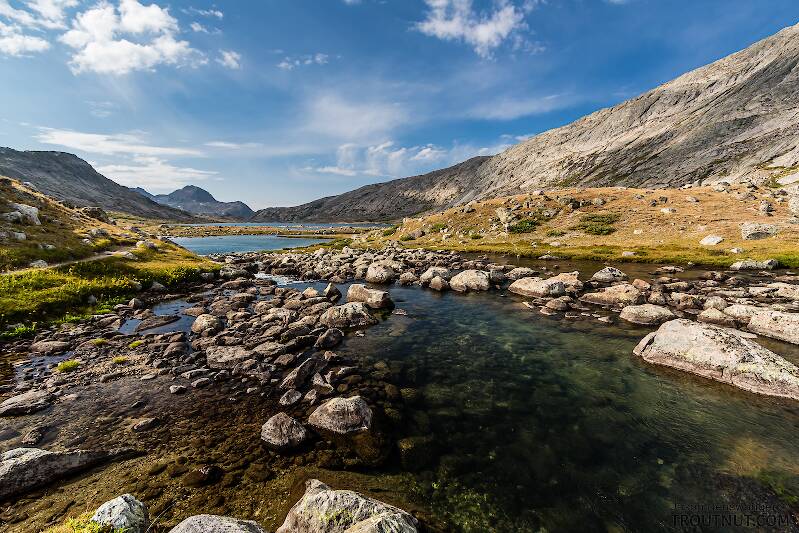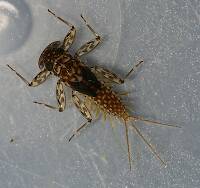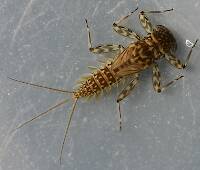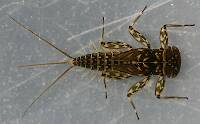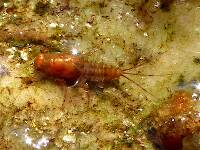
Salmonflies
Pteronarcys californica
The giant Salmonflies of the Western mountains are legendary for their proclivity to elicit consistent dry-fly action and ferocious strikes.
Featured on the forum

This specimen keys pretty easily to Onocosmoecus, and it closely resembles a specimen from Alaska which caddis expert Dave Ruiter recognized as this genus. As with that specimen, the only species in the genus documented in this area is Onocosmoecus unicolor, but Dave suggested for that specimen that there might be multiple not-yet-distinguished species under the unicolor umbrella and it would be best to stick with the genus-level ID. I'm doing the same for this one.

Troutnut is a project started in 2003 by salmonid ecologist Jason "Troutnut" Neuswanger to help anglers and
fly tyers unabashedly embrace the entomological side of the sport. Learn more about Troutnut or
support the project for an enhanced experience here.
Crepuscular on Mar 21, 2012March 21st, 2012, 5:07 am EDT
Maybe it's just me but it seems like I see the most color variation of all of the major mayfly adults in the Ephemerella subvaria. Am I crazy? This female was on my back door yesterday afternoon. Very dark, and no pink on the ventral portion of the abdomen. I realize that most mayflies darken the longer it has been since they emerged, but I'm talking about Hendricksons that have recently emerged. And not the Seratella version that comes later in the season. Does anyone have any idea why the differences in color? Diet? Water chemistry? Genetics?Or do you think I'm imagining it occurring in the Hendricksons more than other species?
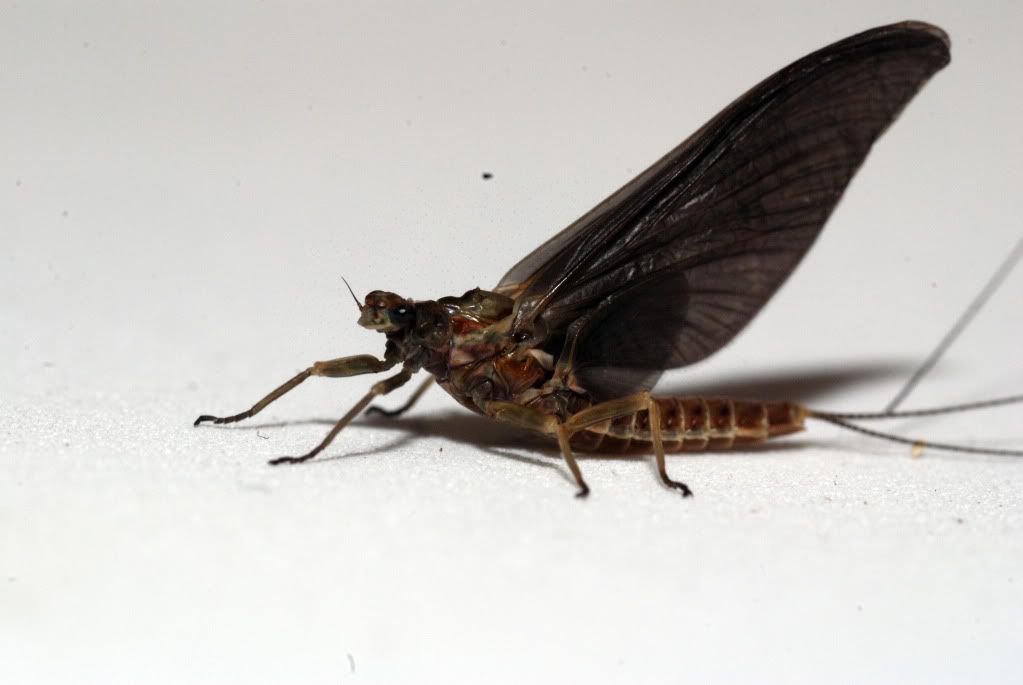





PaulRoberts on Mar 21, 2012March 21st, 2012, 8:30 am EDT
Yours is an esp dark individual, although it is in shadow in the image.
No, you aren't crazy. There are (or used to be) two fly patterns: the "Light Hendrickson" (a tannish version) and the "Dark Hendrickson" (a dusky plum version -as I called it), and it was often passed around that the darks came first, then that the males were dark and females light. Some seemed to claim that the later light was invaria. But there are definitely two color tendencies in the subvaria in central NY.
I wondered if it was stream specific, but eventually caught both sexes in both colors and on the same streams at the same time. In my exp they tend to show the two main variants --light and dark-- which makes me think there is an adaptive reason. Would love to know what that might be. My best guess is related to heat absorption, with one having an advantage due to variations across seasons. Would love to hear other's thoughts.
No, you aren't crazy. There are (or used to be) two fly patterns: the "Light Hendrickson" (a tannish version) and the "Dark Hendrickson" (a dusky plum version -as I called it), and it was often passed around that the darks came first, then that the males were dark and females light. Some seemed to claim that the later light was invaria. But there are definitely two color tendencies in the subvaria in central NY.
I wondered if it was stream specific, but eventually caught both sexes in both colors and on the same streams at the same time. In my exp they tend to show the two main variants --light and dark-- which makes me think there is an adaptive reason. Would love to know what that might be. My best guess is related to heat absorption, with one having an advantage due to variations across seasons. Would love to hear other's thoughts.
Crepuscular on Mar 21, 2012March 21st, 2012, 8:41 am EDT
Paul, This one is especially dark, and if I were anything close to a decent photographer,you would be able to tell that it really was dark. That's what made me think about the variations in color in the Hendricksons. By the way I've been seeing them since last Wed... I don't keep great records but when I go back this is the earliest I think I've seen them. So far the three other that I have captured have all been really dark, and all female from two different streams 30 miles apart.
PaulRoberts on Mar 21, 2012March 21st, 2012, 9:07 am EDT
Oh I can see it's unusually dark -really noticeable in the wings.
I didn't fish PA much, or spring creeks, but in CNY freestones it was an over 52F, end of April, emergence. Are you unseasonably warm there?
I didn't fish PA much, or spring creeks, but in CNY freestones it was an over 52F, end of April, emergence. Are you unseasonably warm there?
Crepuscular on Mar 21, 2012March 21st, 2012, 9:32 am EDT
Oh you could say that! very much so in fact, for the last two weeks our average daily high has been 68.6 and the average daily low has been 43.7. Water temps have been in the 50's. And I usually see them really get going the first or second week of April on the Yellow Breeches.
Wiflyfisher on Mar 21, 2012March 21st, 2012, 10:17 am EDT
John S.
https://WiFlyFisher.com
https://WiFlyFisher.com
Oldredbarn on Mar 21, 2012March 21st, 2012, 10:32 am EDT
By the way I've been seeing them since last Wed... I don't keep great records but when I go back this is the earliest I think I've seen them.
I tie with a group of guys on Monday evenings in the winter. We have done so since the early 90's. We tied an emerger and a spinner version of E subvaria and I joked that maybe we should just skip them this season, since by the time we get to opening day, the last Saturday in April, the Light Henny (E invaria) will already be about. :)
I do not know what to make of this weather! I heard a reporter on the weather channel the other morning say that the weird confluence of weather patterns we are having right now, may actually be a once in a lifetime occurance...We are breaking records up here all week!
In terms of color...Other than a curiosity, it's the least important thing to consider when constructing your flies. That being said, I have reported here before my neurotic dubbing combinations I do myself, my recipes I have kept and adhered to for decades...Thats for my satisfaction, not the fish.
But...color is a strange, strange, thing anyway. It is a matter of perspective and we each have our own and so does the camera. We spot a fly on the wing and it looks different, usually by a long shot, than when we finally have it in hand. A general viewing of the over all bug looks different than if we stop and look really close at it and then again when we look at close ups on this site.
When we do look very close we realize just how varied they are period. There sometimes seem to be a zillion different hues on different bits of their anatomy...It is incredible really. And, as you stated above, they are in flux from the moment they leave the stream floor and emerge in to the air and move on through till their end.
Here in Michigan I have caught Brookies from different streams where in one stream they tend to the lighter side and others towards the darker...The stream bottoms on each of these were very different and mirrored their camouflage...Mother nature's on its own page brother! We will probably never totally figure it out, but its fun trying, no?! :)
I have to disagree with my wise friend Paul above...Yes you are crazy. Crazy as a loon. And so are the rest of us goof-balls splashing around in a stream somewhere staring at bugs, fish, birds, moss, lichen, the sky, our belly-buttons...:) But at least we are "out-there"!
Spence
PS I just posted this and noticed John's great photo as well. The difference seen there between male and female is common and the two sexes from the same species are usually different in color and size etc...How they find each other is anyones guess...:) Look at my pictures posted here under the large L recurvata (Hex cousin)...The differences there are rather apparent as well.
"Even when my best efforts fail it's a satisfying challenge, and that, after all, is the essence of fly fishing." -Chauncy Lively
"Envy not the man who lives beside the river, but the man the river flows through." Joseph T Heywood
"Envy not the man who lives beside the river, but the man the river flows through." Joseph T Heywood
Crepuscular on Mar 21, 2012March 21st, 2012, 11:07 am EDT
Spence believe me I've thought the same thing about missing them, we are religated to "special regulation" waters, which are no kill, delayed harvest, trophy trout etc. waters right now.Which is fine I've been fishing and catching on dryflies, so I'm happy about that, but I must admit that I've been a little bit concerned that I'm gonna miss something somewhere due to this warm weather especially in the Northern portion of PA. I drove down to a particular section of open water along a local creek on Sunday, and was dreading that the water would be covered with Hendricksons! It was not, but there were a couple flying around. Luckily, we only have to wait until the 31st to fish all the waters in the southern portion of the State. And yeah I'm a member of the size, presentation,then color(within reason) faction, but I get really caught up in the minutae of all this stuff. Plus it's very hard not to notice a E. subvaria that dark at eye level on my screen door.
John, those two that you photographed are pretty close to what I usually see on most waters here in PA.
John, those two that you photographed are pretty close to what I usually see on most waters here in PA.
Entoman on Mar 21, 2012March 21st, 2012, 11:19 am EDT
Eric -
You have brought up the elephant in the room and I'm afraid this issue is more universal. E. excrucians (PMD) and M. vicarium (March Brown) quickly come to mind as other examples.
A linchpin of the "match the Hatch" philosophy has been the use of scientific names to "clear away the confusion" caused by the use of common names when discussing hatches. Most of us still take this as a given. The problem is it isn't true. What if you didn't provide the picture or a description? Let's say you called it either an E. subvaria female or a Mahogany Dun. If you used the former, we'd all show up with tannish imitations. If the latter, we wouldn't know the scientific name and probably even assume it was the wrong species, but at least we'd be ready with the right colored dry flies.:)
I raised this issue recently with a topic on little dark Winter stones. Schwiebert and other authors worked with the information of the day, largely based on the work of Needham's The Biology of Mayflies and previous works by anglers like Preston Jennings. It was just assumed by most of us that a given species was pretty much a certain color and size and lived in a certain type of habitat. To this day, I'm still looking for the large tan E. infrequens Schwiebert described in Matching the Hatch. For the first twenty or so years, I thought the sulfur flies I was fishing over had to be the eastern E. dorothea, which of course was impossible (so it was thought at the time. Now we know different). This happened I believe because the samples of the day were small and the number of anglers that paid much attention to what they were seeing astream was even smaller. There certainly weren't the astute multitudes observing and photographing them all over the country. The reality is science is teaching us more and more every year about the incredible variety exhibited in some speciation due to adaptability, variability, intergrading, and even the possibility of cryptic species. As more and more varieties were discovered, the initial response was to label them all different species, but science over time has corrected this. So, we as anglers have to let go of comfortable species names like E. inermis, B. vagans, S. fuscum, and P. anoka. I think the only way forward for us anglers is to use the scientific names of the day but with a descriptive phrase attached. In this case a slate-winged mahogany subvaria.
Paul-
The issue of an early Spring was talked about by A. K. Best, the famous angler/tier out your way. I remember reading in one of his books that in his WI days, he dreamed of a year when the winter would be mild enough that he could fish over Hennies on opening day like many of the "oldtimers" remembered. Looks like this is the year! :)
Maybe it's just me but it seems like I see the most color variation of all of the major mayfly adults in the Ephemerella subvaria. Am I crazy?
You have brought up the elephant in the room and I'm afraid this issue is more universal. E. excrucians (PMD) and M. vicarium (March Brown) quickly come to mind as other examples.
A linchpin of the "match the Hatch" philosophy has been the use of scientific names to "clear away the confusion" caused by the use of common names when discussing hatches. Most of us still take this as a given. The problem is it isn't true. What if you didn't provide the picture or a description? Let's say you called it either an E. subvaria female or a Mahogany Dun. If you used the former, we'd all show up with tannish imitations. If the latter, we wouldn't know the scientific name and probably even assume it was the wrong species, but at least we'd be ready with the right colored dry flies.:)
I raised this issue recently with a topic on little dark Winter stones. Schwiebert and other authors worked with the information of the day, largely based on the work of Needham's The Biology of Mayflies and previous works by anglers like Preston Jennings. It was just assumed by most of us that a given species was pretty much a certain color and size and lived in a certain type of habitat. To this day, I'm still looking for the large tan E. infrequens Schwiebert described in Matching the Hatch. For the first twenty or so years, I thought the sulfur flies I was fishing over had to be the eastern E. dorothea, which of course was impossible (so it was thought at the time. Now we know different). This happened I believe because the samples of the day were small and the number of anglers that paid much attention to what they were seeing astream was even smaller. There certainly weren't the astute multitudes observing and photographing them all over the country. The reality is science is teaching us more and more every year about the incredible variety exhibited in some speciation due to adaptability, variability, intergrading, and even the possibility of cryptic species. As more and more varieties were discovered, the initial response was to label them all different species, but science over time has corrected this. So, we as anglers have to let go of comfortable species names like E. inermis, B. vagans, S. fuscum, and P. anoka. I think the only way forward for us anglers is to use the scientific names of the day but with a descriptive phrase attached. In this case a slate-winged mahogany subvaria.
Paul-
The issue of an early Spring was talked about by A. K. Best, the famous angler/tier out your way. I remember reading in one of his books that in his WI days, he dreamed of a year when the winter would be mild enough that he could fish over Hennies on opening day like many of the "oldtimers" remembered. Looks like this is the year! :)
"It's not that I find fishing so important, it's just that I find all other endeavors of Man equally unimportant... And not nearly as much fun!" Robert Traver, Anatomy of a Fisherman
PaulRoberts on Mar 21, 2012March 21st, 2012, 11:22 am EDT
I just looked at my transparencies of subvaria duns and I have images of light and dark ones. The lights are actually tan ventrally, the darks a deep plum color. I have an image of a very dark one, like yours Crepuscular, with wings nearly black. Realize though, I've caught both males and females in both colors, and on the same day on the same water.
Crepuscular on Mar 21, 2012March 21st, 2012, 11:46 am EDT
It was just assumed by most of us that a given species was pretty much a certain color and size and lived in a certain type of habitat.
When I think back about this issue, It became very apparent to me at an early age that the photographs I was seeing in fly pattern books did not always, and actually very infrequently, matched what I was seeing on the stream. This is why most of us have several different versions of the same fly in our boxes I guess. I began tying for individual hatches on individual streams, and that while yes often times when traveling to new waters I had most of my bases covered, it never failed that I would come across a trait of local mayfly, that would differ slightly from the same mayfly I had encountered before. So I would have to factor that into my tying for that fly on that stream.
So when thinking about tying a Hendrickson dry fly, I now had to be concerned with the diet of the fox. So I could get the exact urine burn color :)
Entoman on Mar 21, 2012March 21st, 2012, 11:56 am EDT
When I think back about this issue, It became very apparent to me at an early age that the photographs I was seeing in fly pattern books did not always, and actually very infrequently, matched what I was seeing on the stream.
Yep, as a westerner growing up the problem was even more obvious as none of the literature besides Schwiebert even dealt with the West, and his book's western input was largely based on only a few watersheds in CO. We were largely on our own in this respect.
"It's not that I find fishing so important, it's just that I find all other endeavors of Man equally unimportant... And not nearly as much fun!" Robert Traver, Anatomy of a Fisherman
Entoman on Mar 21, 2012March 21st, 2012, 12:34 pm EDT
Does anyone have any idea why the differences in color? Diet? Water chemistry? Genetics?
Definitely the last two. Another factor is substrate. Many of the species that inhabit the clear West Slope rivers out here are dark and light blotched to match the granite substrate. The same species that live in other waters with weeds or algea covered cobble are more solid colored. Check out these two examples from the D. grandis/spinifera species group:
http://www.flyfishingentomology.com/forum/Replies_Display.php?t=0144
http://www.flyfishingentomology.com/forum/Replies_Display.php?t=0025
"It's not that I find fishing so important, it's just that I find all other endeavors of Man equally unimportant... And not nearly as much fun!" Robert Traver, Anatomy of a Fisherman
PaulRoberts on Mar 21, 2012March 21st, 2012, 12:50 pm EDT
Does anyone have any idea why the differences in color? Diet? Water chemistry? Genetics?
Definitely the last two. Another factor is substrate. Many of the species that inhabit the clear West Slope rivers out here are dark and light blotched to match the granite substrate. The same species that live in other waters with weeds or algea covered cobble are more solid colored. Check out these two examples from the D. grandis/spinifera species group:
http://www.flyfishingentomology.com/forum/Replies_Display.php?t=0144
http://www.flyfishingentomology.com/forum/Replies_Display.php?t=0025
Such an explanation works for nymphs, but for duns I think there's something else at play with the Hennies.
Entoman on Mar 21, 2012March 21st, 2012, 1:23 pm EDT
Paul,
Yes, water chemistry and genetics are probably the biggies. I just included the substrate influence to round out our discussion regarding variability by covering all the life stages. I thought it was interesting, and not mentioned much.
BTW - regarding the lack of info for us poor westerners until very recently (in terms of historical perspective), I don't feel too sorry for us. The truth is very few cared and it wasn't all that important. My dad fished in the 40's and 50's with only a handful of patterns and caught all the fish he wanted, and in numbers we rarely see anymore. He was a dry fly purist when it came to flies. He used a Gray Hackle Yellow to match the sulfurs, the Professor to match the olives, and the California Mosquito to match all the rest. He only resorted to these though if they wouldn't take a California Coachman or Rio Grande King.:) They all had red tails (he explained the fish were attracted to red). He also carried some Trudes and the Lt. & Dk. Caddis Bucktails for caddis & stones. That was his whole selection. Before the tailwaters and big Interstates, trout fishing was largely a Summer proposition after runoff. The numbers of fly fisherman were few, and he often told me he VERY rarely ran into another one, let alone a very competent one. This was still true on many of our lakes well into the 80's. Those were simpler times... Exploding population and that movie changed everything.:)
Such an explanation works for nymphs, but for duns I think there's something else at play with the Hennies.
Yes, water chemistry and genetics are probably the biggies. I just included the substrate influence to round out our discussion regarding variability by covering all the life stages. I thought it was interesting, and not mentioned much.
BTW - regarding the lack of info for us poor westerners until very recently (in terms of historical perspective), I don't feel too sorry for us. The truth is very few cared and it wasn't all that important. My dad fished in the 40's and 50's with only a handful of patterns and caught all the fish he wanted, and in numbers we rarely see anymore. He was a dry fly purist when it came to flies. He used a Gray Hackle Yellow to match the sulfurs, the Professor to match the olives, and the California Mosquito to match all the rest. He only resorted to these though if they wouldn't take a California Coachman or Rio Grande King.:) They all had red tails (he explained the fish were attracted to red). He also carried some Trudes and the Lt. & Dk. Caddis Bucktails for caddis & stones. That was his whole selection. Before the tailwaters and big Interstates, trout fishing was largely a Summer proposition after runoff. The numbers of fly fisherman were few, and he often told me he VERY rarely ran into another one, let alone a very competent one. This was still true on many of our lakes well into the 80's. Those were simpler times... Exploding population and that movie changed everything.:)
"It's not that I find fishing so important, it's just that I find all other endeavors of Man equally unimportant... And not nearly as much fun!" Robert Traver, Anatomy of a Fisherman
Wiflyfisher on Mar 21, 2012March 21st, 2012, 5:59 pm EDT
Yes, water chemistry and genetics are probably the biggies. I just included the substrate influence to round out our discussion regarding variability by covering all the life stages. I thought it was interesting, and not mentioned much.
The photo I took of the two duns are from a dark, iron-colored trout stream. I am sure anything is possible, but it could just be a severe case of "sunburn". :-)
John S.
https://WiFlyFisher.com
https://WiFlyFisher.com
Feathers5
Posts: 287
Posts: 287
Feathers5 on Mar 22, 2012March 22nd, 2012, 4:31 am EDT
You guys are making this so difficult. When fishing dry flies all you need to do is to be on the stream with Gutcutter. If it's a dun or emerger he's on it like stink on --it.
Bruce, Lastchance, etc. etc.
Bruce, Lastchance, etc. etc.
PaulRoberts on Mar 22, 2012March 22nd, 2012, 7:01 am EDT
BTW - regarding the lack of info for us poor westerners until very recently (in terms of historical perspective), I don't feel too sorry for us. The truth is very few cared and it wasn't all that important. My dad fished in the 40's and 50's with only a handful of patterns and caught all the fish he wanted, and in numbers we rarely see anymore. He was a dry fly purist when it came to flies. He used a Gray Hackle Yellow to match the sulfurs, the Professor to match the olives, and the California Mosquito to match all the rest. He only resorted to these though if they wouldn't take a California Coachman or Rio Grande King.:) They all had red tails (he explained the fish were attracted to red). He also carried some Trudes and the Lt. & Dk. Caddis Bucktails for caddis & stones. That was his whole selection. Before the tailwaters and big Interstates, trout fishing was largely a Summer proposition after runoff. The numbers of fly fisherman were few, and he often told me he VERY rarely ran into another one, let alone a very competent one. This was still true on many of our lakes well into the 80's. Those were simpler times... Exploding population and that movie changed everything.:)
Yes, tailwaters changed the world of trout fishing enormously. Chill down a big productive low order river and put trout in it and you have a different ballgame from 90% of the trout water out there.
Entoman on Mar 22, 2012March 22nd, 2012, 9:26 am EDT
Guys -
John's funny about sunburn reminded me of another theory for the dark duns. The dark ones are better adapted for absorbing heat on cold blustery spring days. Not a factor this year, I guess...:)
Bruce-
Are you buttering Tony up so that he'll share some of his cool patterns with you on your upcoming trip? Shameless...:)LOL
John's funny about sunburn reminded me of another theory for the dark duns. The dark ones are better adapted for absorbing heat on cold blustery spring days. Not a factor this year, I guess...:)
Bruce-
Are you buttering Tony up so that he'll share some of his cool patterns with you on your upcoming trip? Shameless...:)LOL
"It's not that I find fishing so important, it's just that I find all other endeavors of Man equally unimportant... And not nearly as much fun!" Robert Traver, Anatomy of a Fisherman
Wiflyfisher on Mar 22, 2012March 22nd, 2012, 9:46 am EDT
Guys -
John's funny about sunburn reminded me of another theory for the dark duns. The dark ones are better adapted for absorbing heat on cold blustery spring days. Not a factor this year, I guess...:)
Interesting you mentioned that... I was watching "Bugs of the Underworld" the other night and Ralph mentioned the reason the early season stoneflies are all very dark is to better absorb the heat from the sunlight.
This winter I have been studying the Emphemerlla emergers and decided to tie a new emerger pattern that I think does a better job representing the dun emerging on the surface from it's nymphal case.


Testing in water...

John S.
https://WiFlyFisher.com
https://WiFlyFisher.com
Quick Reply
Related Discussions
Topic
Replies
Last Reply
1
Aug 21, 2007
by Gene
by Gene
4
Sep 27, 2014
by Millcreek
by Millcreek
4
Apr 21, 2007
by PeterO
by PeterO

